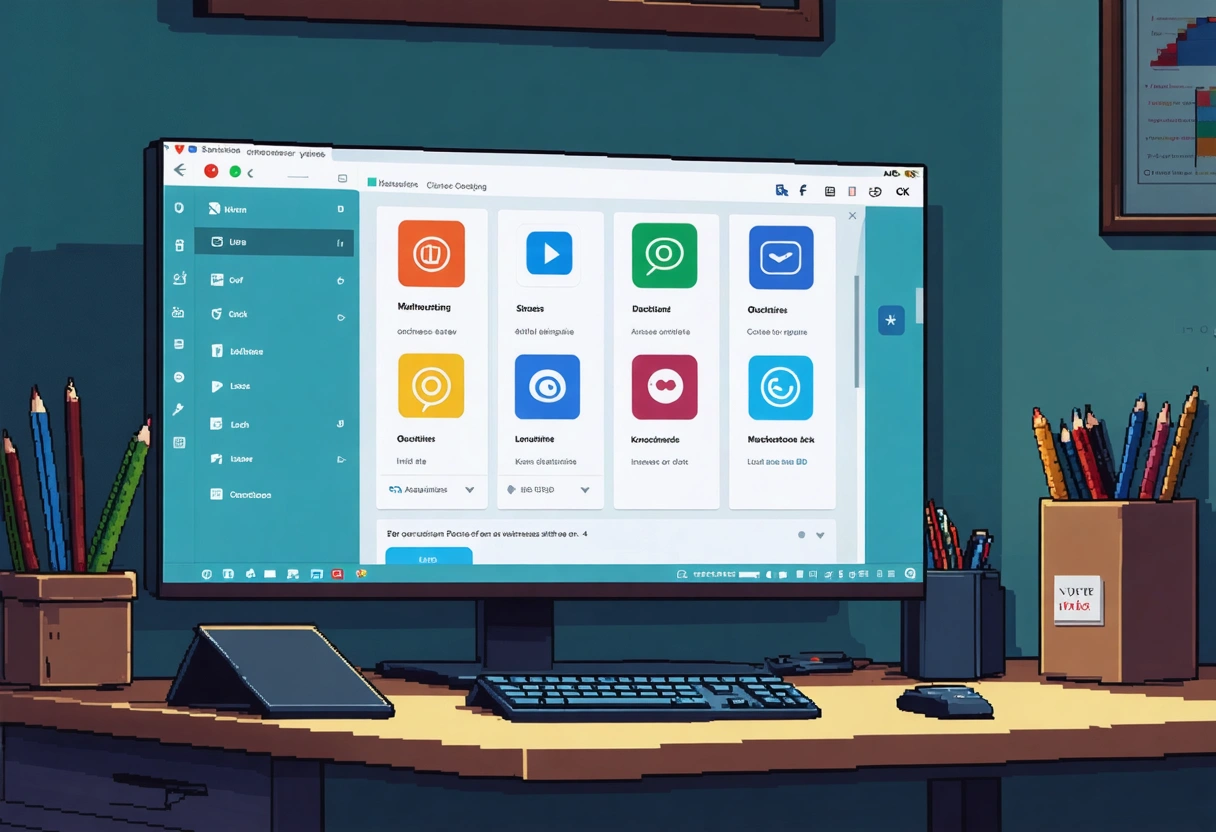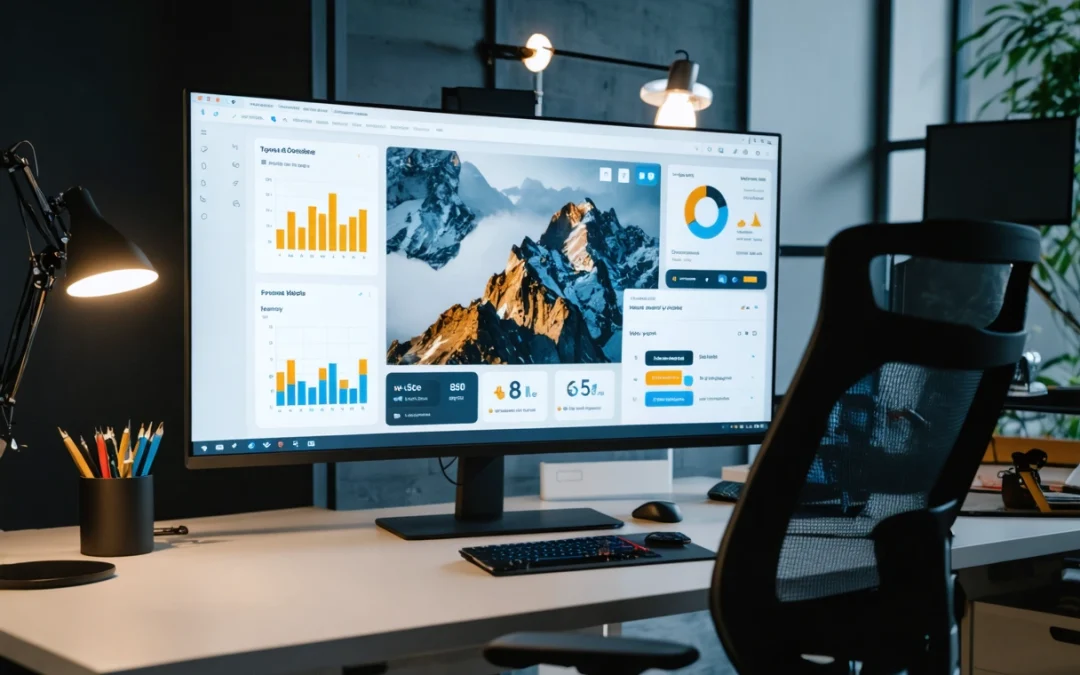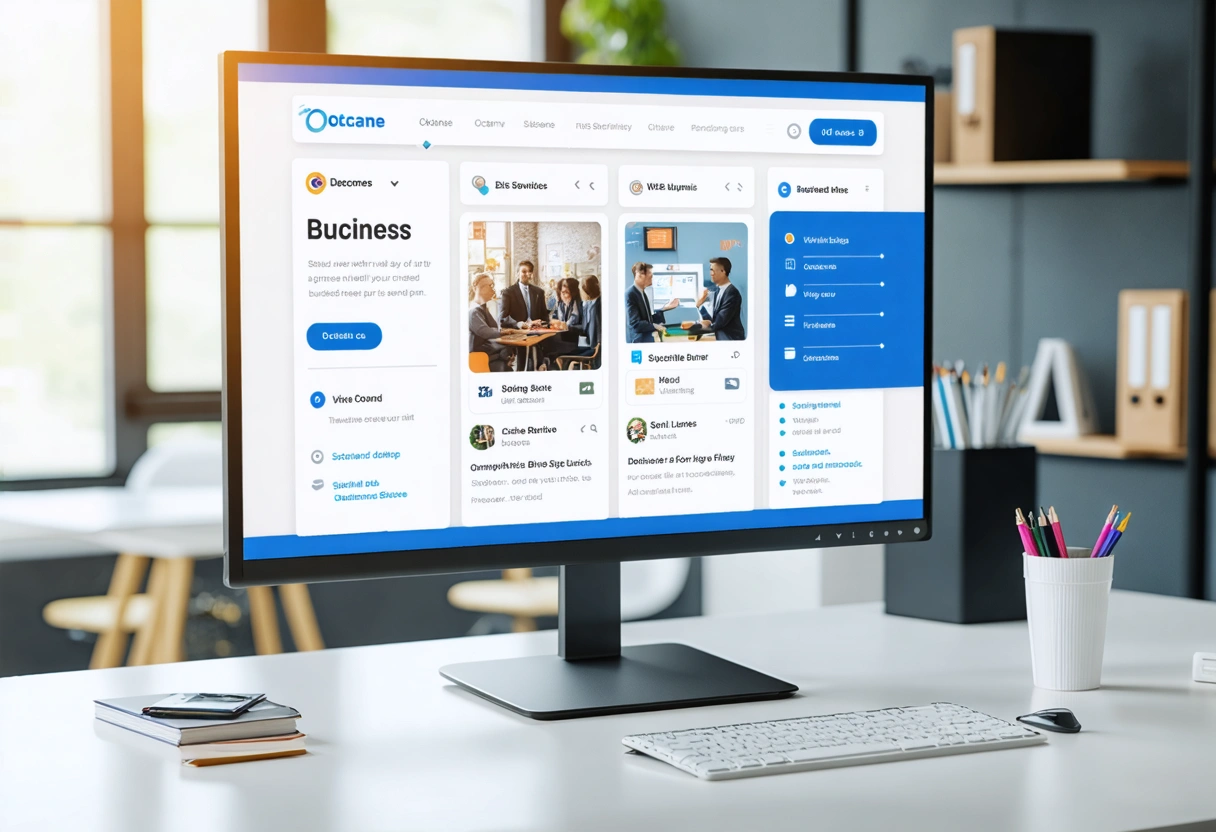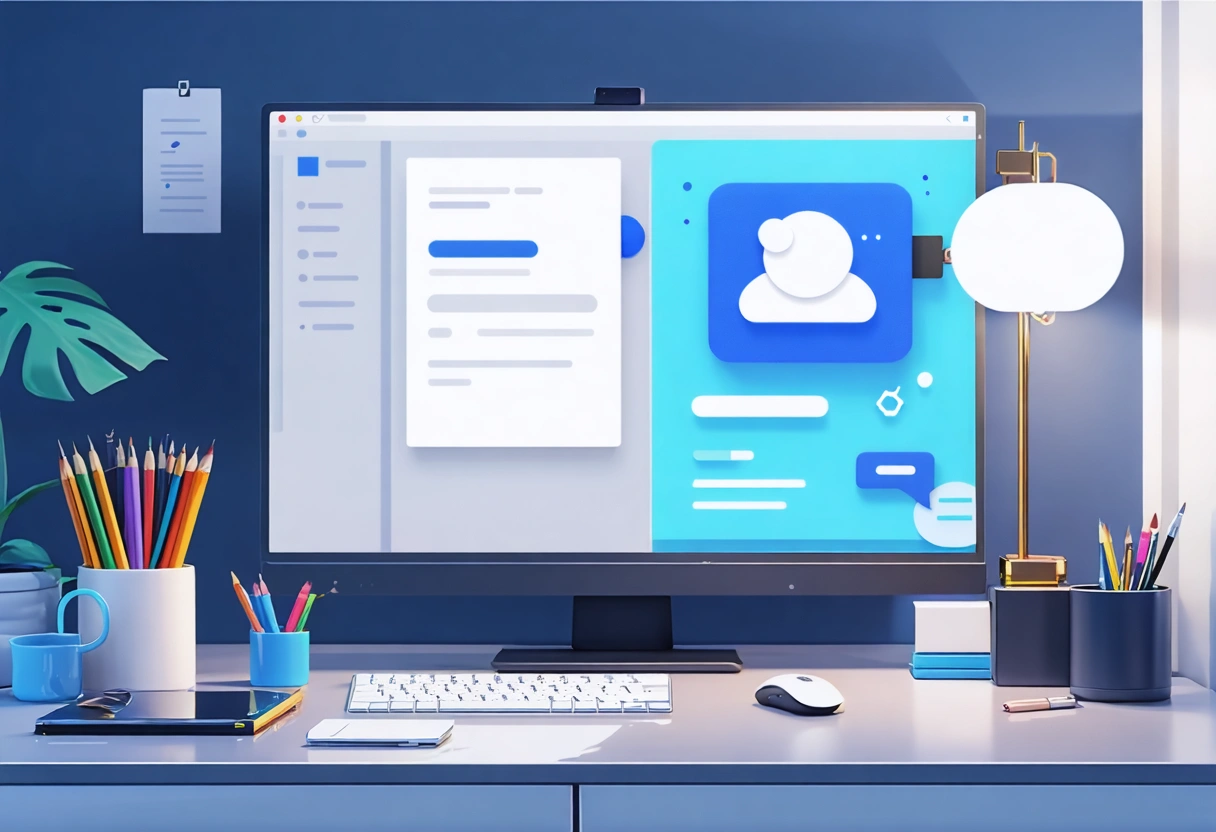
by Guru IS | Nov 3, 2025 | Case Studies
Introduction to Local SEO and Its Importance
In the rapidly evolving digital landscape, businesses are constantly looking for ways to stand out in the crowded online marketplace. One of the most effective strategies for achieving this is through local SEO, a powerful tool that helps businesses reach local customers right when they are searching for services or products in their vicinity. This blog post explores an in-depth case study conducted by Guru Internet Services, showcasing how leveraging local SEO can help a business dominate its market.
Local SEO focuses on optimizing a business’s online presence to attract more business from relevant local searches. This is especially crucial for small to medium-sized enterprises that operate on a regional level rather than a national one. By optimizing their local SEO, businesses can drive more traffic from their target demographic, enhance their brand visibility, and boost overall sales.
Understanding the Basics of Local SEO
Local SEO involves several strategies and tactics aimed at improving a company’s visibility to local searchers. This includes optimizing Google My Business listings, managing online reviews, and ensuring that the business’s name, address, and phone number (NAP) are consistent across all online platforms. By focusing on these elements, businesses can appear in the coveted local pack and improve their chances of being found by potential customers.
One critical element of local SEO is the optimization of Google My Business listings. This free tool by Google allows businesses to manage their online presence across the search engine and its growing portfolio of utilities, including Google Maps. Ensuring that this listing is accurate and complete, with updated contact information and business hours, significantly boosts a business’s visibility.
Case Study: Guru Internet Services and Local SEO
Guru Internet Services conducted an expansive case study to assess how local SEO strategies can transform a business’s market presence. The research focused on a mid-sized restaurant chain that was struggling to draw local customers despite having a strong product offering. The case study aimed to identify the challenges faced by the business and apply local SEO strategies to overcome them.

The primary issues identified were inconsistent NAP details across platforms, a lack of customer reviews, and poor optimization of the restaurant’s Google My Business listing. By addressing these issues, the team at Guru Internet Services sought to improve the restaurant’s visibility in local search results and drive more foot traffic to its locations.
Strategies Implemented for Local SEO Success
Guru Internet Services employed a comprehensive approach to tackle the restaurant’s local SEO challenges, implementing several key strategies to enhance its online presence. The first step involved a thorough audit of the restaurant’s existing online footprint to identify inconsistencies and areas for improvement. This audit revealed discrepancies in NAP data across various platforms, which were promptly corrected for consistency and accuracy.
Next, the team focused on optimizing the restaurant’s Google My Business listing. This involved updating the business description with relevant keywords, adding high-quality images of the restaurant and its offerings, and ensuring that business hours and contact information were accurate. Additionally, the listing was enhanced with engaging posts about special promotions and events to attract potential customers.
Another critical strategy implemented was the encouragement of customer reviews. Online reviews play a significant role in local SEO, as they contribute to a business’s credibility and influence customer decisions. The restaurant was encouraged to engage with customers and request reviews, responding promptly to feedback to build a positive online reputation.
Results Achieved Through Local SEO Optimization
The results of the local SEO optimization were impressive. Within three months, the restaurant experienced a significant increase in local search visibility, with a 25% rise in online traffic and a 30% boost in foot traffic to its physical locations. The business’s Google My Business listing saw a substantial increase in views and interactions, leading to more inquiries and reservations.

Furthermore, the restaurant’s online reputation improved significantly, with a 40% increase in positive reviews. Customers frequently mentioned the ease of finding the restaurant online and the appealing images that accurately represented their dining experience. This surge in positive feedback not only enhanced the restaurant’s credibility but also attracted new patrons who were previously unaware of its offerings.
Lessons Learned and Future Implications
This case study highlights the transformative power of local SEO for businesses looking to enhance their market presence. By focusing on key elements such as NAP consistency, Google My Business optimization, and customer engagement, businesses can significantly improve their visibility to local customers and drive growth.
Moreover, the insights gained from this study emphasize the importance of maintaining an active and engaging online presence. Businesses must regularly update their online listings, encourage customer reviews, and respond to feedback to stay competitive in the digital age. The results achieved by the restaurant chain serve as a testament to the effectiveness of these strategies and offer a blueprint for other businesses looking to succeed in their local markets.
Embracing Local SEO for Market Dominance
In conclusion, local SEO is an indispensable tool for businesses aiming to connect with local customers and dominate their market. The case study conducted by Guru Internet Services demonstrates how a strategic approach to local SEO can produce tangible results and drive significant business growth.

Businesses seeking to replicate this success should focus on optimizing their online presence, engaging with customers, and remaining vigilant about maintaining accurate and consistent information across all platforms. By doing so, they can enhance their visibility, build a strong online reputation, and ultimately, achieve market dominance.
For further insights into local SEO strategies and best practices, consider exploring resources such as Search Engine Land’s local SEO guide and Neil Patel’s local SEO checklist. These resources provide comprehensive information and actionable tips to help businesses leverage local SEO effectively.
Implementing Advanced Local SEO Techniques
While the fundamental aspects of local SEO, such as ensuring NAP consistency and optimizing Google My Business listings, are crucial, businesses looking to further dominate their market should also consider implementing advanced techniques. These strategies can propel a business beyond its competitors by enhancing visibility and engagement even more.
One advanced technique is the use of local content marketing. By creating content that is specifically tailored to the local audience, businesses can position themselves as experts in their area. This might include writing blog posts about local events, news, or issues that resonate with the community. For instance, a local HVAC company might publish content about preparing homes for seasonal weather changes specific to the region. This not only provides value to the local audience but also boosts local search relevance.
Harnessing Social Media for Local Engagement
Social media platforms provide another avenue for enhancing local SEO efforts. These platforms are not just for global reach; they are incredibly effective for engaging with local audiences. By posting regularly about local happenings, promotions, and community involvement, businesses can foster a sense of community and loyalty among local customers.
Businesses should also encourage user-generated content on social media. This includes encouraging customers to share their experiences and tag the business in their posts. User-generated content acts as a form of social proof and can greatly influence potential customers. For further strategies on leveraging social media for local SEO, consider reading this detailed guide on social media optimization.
Utilizing Local Listings and Directories
Another effective strategy for improving local SEO is ensuring that a business is listed on relevant local directories and listings. These platforms often rank highly in local search results and can drive significant traffic to a business’s website. Examples include Yelp, Yellow Pages, and local Chamber of Commerce directories.

It is vital to ensure that the information on these directories is up-to-date and accurate. Many businesses overlook these platforms, missing out on potential local traffic. Claiming and optimizing these listings can improve a business’s local search visibility and credibility. For a comprehensive list of directories that can boost local SEO efforts, explore this resource on local citation sites.
The Role of Structured Data in Local SEO
Structured data markup, also known as schema markup, is an advanced SEO strategy that provides search engines with explicit information about a business. By using local business schema markup, businesses can help search engines understand their local relevance, which can enhance their visibility in search results.
Implementing structured data can lead to rich snippets in search results, which can increase click-through rates and drive more traffic to a business’s website. For businesses aiming to implement structured data, this introduction to structured data provides a detailed insight into how to get started.
Monitoring and Analyzing Local SEO Performance
Once local SEO strategies have been implemented, it is crucial to continuously monitor and analyze their performance. This involves tracking key metrics such as local search rankings, website traffic, and conversion rates. By doing so, businesses can identify which strategies are working and which need adjustment.

Tools like Google Analytics and Google Search Console are invaluable for monitoring performance. They provide insights into how users are finding a business online and what actions they are taking once they arrive. Additionally, tracking online reviews and social media mentions can provide a broader understanding of a business’s local reputation.
Regular analysis allows businesses to stay ahead of trends and make informed decisions about their local SEO strategies. For those looking to delve deeper into analytics, this Google Analytics Academy offers valuable courses and insights.
Adapting to Changing SEO Trends
Finally, it is important for businesses to remain adaptable and responsive to the ever-changing landscape of SEO. Search engine algorithms are continually updated, and consumer behavior evolves over time. Staying informed about the latest SEO trends and updates can ensure that a business remains competitive and relevant.
Businesses should also be open to experimenting with new strategies and tools. The digital marketing landscape is dynamic, and what works today may not be effective tomorrow. By maintaining a flexible approach and being willing to adapt, businesses can continue to thrive in the local market.
Final Thoughts on Local SEO Mastery
Dominating the local market through SEO requires a strategic and multifaceted approach. From foundational practices like NAP consistency and Google My Business optimization to advanced techniques like structured data and local content marketing, there are numerous ways businesses can enhance their local presence.
By implementing the strategies outlined in this case study and remaining vigilant about monitoring performance and adapting to new trends, businesses can achieve significant success in their local markets. Local SEO is not a one-time task but an ongoing process that requires dedication and creativity.
The insights shared in this post, along with the additional resources linked throughout, provide a comprehensive guide for businesses looking to leverage local SEO to its full potential and achieve market dominance.

by Guru IS | Nov 3, 2025 | Best Practices
In the digital age, mastering Local SEO is crucial for businesses aiming to boost their online presence. As we approach 2025, the landscape of search engine optimization continues to evolve. Local SEO has emerged as a pivotal strategy for businesses that want to attract customers within a specific geographical area. By optimizing your business for local search, you not only enhance visibility but also build a strong local brand identity that resonates with your community.
Local SEO is not just about getting your business listed on Google Maps or having a high ranking in search results. It’s a comprehensive approach that involves understanding the nature of your local market, the behavior of your target audience, and the unique elements that set your business apart from competitors. In this blog post, we’ll delve into the best practices for mastering Local SEO, ensuring your business is well-positioned to thrive in the coming years.
Understanding the Basics of Local SEO
To effectively leverage Local SEO, it’s important to understand its core elements. At its heart, Local SEO focuses on optimizing your online presence to attract more business from local searches. These searches include specific geographic qualifiers, such as a city, state, or “near me” searches that are becoming increasingly popular with the rise of mobile search.
Local SEO is different from traditional SEO in that it targets search queries that have local intent. This means that the searcher is looking for something within a specific location. To capitalize on this, businesses must ensure their online information is accurate and optimized for local search engines. This includes optimizing your Google My Business profile, ensuring your NAP (Name, Address, Phone Number) information is consistent across all platforms, and gathering positive customer reviews.
Importance of Google My Business

One of the foundational elements of Local SEO is Google My Business (GMB). GMB is a free tool that allows you to manage how your business appears on Google Search and Maps. A well-optimized GMB profile can significantly enhance your local search visibility. Ensure that your GMB profile is complete and accurate, including business hours, contact information, and photos of your business. Regularly posting updates and engaging with customer reviews on GMB can also boost your local SEO efforts.
Consistency in NAP Information
Another critical aspect of Local SEO is maintaining consistency in your NAP information. This consistency helps search engines verify the legitimacy of your business. Discrepancies in your business name, address, or phone number across different platforms can confuse search engines and potential customers, leading to a lower ranking in search results. Use tools like Moz Local or Yext to manage your listings and ensure consistency.
Enhancing Local Content and Keywords
Creating locally relevant content is a powerful way to boost your Local SEO. Consider developing blog posts, articles, or resources that address local issues or events. This not only helps you engage with your local audience but also provides valuable content that can improve your search rankings.
Incorporating local keywords into your content strategy is essential. These keywords should naturally fit into your content and align with what your target audience is searching for. Use tools like Google Keyword Planner or SEMrush to research local keywords and identify opportunities to integrate them into your content.
Utilizing Local Keywords

Local keywords are phrases that include specific geographic locations. For example, if you’re a bakery in Austin, Texas, using keywords like “Austin bakery” or “best cakes in Austin” can help you reach potential customers in your area. Integrate these keywords into your website content, meta descriptions, and even in your image alt tags to improve your local search visibility.
Creating Localized Content
Localized content resonates with your community and can establish your business as a local authority. Consider writing about local events, news, or partnerships. You could also feature local customers, success stories, or testimonials. This not only strengthens your connection with the community but can also generate local backlinks, further enhancing your Local SEO.
Building Local Citations and Backlinks
Citations are online mentions of your business’s name, address, and phone number. They play a crucial role in local search rankings. The more citations your business has, the more credible it appears to search engines. However, it’s not just about quantity; the quality and consistency of these citations are equally important.
Backlinks from local websites and organizations can also bolster your Local SEO efforts. Partner with local businesses, sponsor community events, or join local chambers of commerce to gain valuable backlinks. These links signal to search engines that your business is a reputable member of the local community.
Leveraging Business Directories

List your business in reputable online directories such as Yelp, Yellow Pages, and industry-specific directories. These listings not only provide valuable citations but also increase your business’s online visibility. Ensure your business information is consistent across all directories to improve your local search ranking.
Building Relationships with Local Businesses
Collaborating with other local businesses can provide mutual benefits. Consider co-hosting events, cross-promoting services, or developing joint marketing campaigns. These partnerships can lead to additional exposure and opportunities for backlinks from other local websites.
Optimizing for Mobile and Voice Search
As mobile and voice searches become more prevalent, optimizing for these technologies is crucial for Local SEO success. With more people using smartphones and voice-activated devices to search for local businesses, ensuring your website is mobile-friendly is imperative.
Voice search optimization requires a slightly different approach compared to traditional text-based searches. Voice searches tend to be more conversational, so incorporating natural language and question-based keywords into your content can improve your chances of appearing in voice search results.
Ensuring Mobile-Friendly Design

A mobile-friendly website is essential for engaging users and improving your local search rankings. Google prioritizes mobile-friendly sites in its search results, making it critical to ensure your website is responsive and easy to navigate on mobile devices. Use Google’s Mobile-Friendly Test tool to check your site’s compatibility and address any issues that arise.
Optimizing for Voice Search
With the rise of digital assistants like Alexa and Google Assistant, optimizing for voice search is becoming increasingly important. Focus on long-tail keywords and natural language that reflect how people speak rather than type. Answer common questions your customers might ask and consider creating an FAQ page to capture these voice queries.
Monitoring and Analyzing Local SEO Performance
Regularly monitoring and analyzing your Local SEO performance is essential to understand what’s working and where improvements are needed. Tools like Google Analytics and Google Search Console provide valuable insights into your local search performance.
Track key metrics such as local search traffic, conversion rates, and customer reviews. These insights can help you adjust your strategy, optimize your efforts, and ultimately enhance your local search visibility.
Using Analytics Tools

Google Analytics is a powerful tool for tracking your Local SEO performance. Set up goals to track conversions from local searches and monitor user behavior on your website. Analyze which pages or content drive the most local traffic and focus on optimizing these areas further.
Adjusting Strategies Based on Insights
Based on the data you collect, adjust your Local SEO strategies accordingly. If you notice certain keywords driving more traffic, create more content around those terms. If customer reviews highlight specific areas of improvement, address these concerns promptly to enhance your reputation.
Takeaways
Mastering Local SEO is an ongoing process that requires dedication and strategic planning. By understanding the fundamentals, optimizing your online presence, and engaging with your local community, you can significantly enhance your business’s visibility in local search results. As we move towards 2025, the importance of Local SEO will only continue to grow, making it a vital component of any successful digital marketing strategy.
Stay informed about the latest trends, continually refine your strategies, and be proactive in your efforts to connect with your local audience. With the right approach, Local SEO can be a powerful tool for driving business growth and establishing a strong online presence in your community.

by Guru IS | Oct 31, 2025 | Case Studies
The Power of Local SEO: How Guru Internet Services Boosted Local Businesses
In today’s digital age, the importance of a strong online presence cannot be overstated. For local businesses, tapping into the power of local search engine optimization (SEO) can be a game-changer. While many businesses focus on broad-reaching SEO strategies, local SEO is specifically tailored to help businesses capture the attention of customers in their immediate area. This approach is essential for businesses that rely on foot traffic and local clientele. Guru Internet Services has been at the forefront of helping local businesses achieve remarkable results through targeted local SEO strategies. In this article, we’ll explore the transformative impact of local SEO through detailed case studies that highlight the successes achieved by those who have partnered with Guru Internet Services.
Understanding Local SEO and Its Importance
Local SEO is the process of optimizing a business’s online presence to attract more customers from relevant local searches. It involves a variety of strategies, including optimizing Google My Business listings, managing online reviews, and creating locally-focused content. When executed correctly, these strategies can significantly boost a business’s visibility in local search results, driving traffic both online and offline.
One of the key components of local SEO is the optimization of Google My Business listings. This free tool allows businesses to manage how they appear on Google Search and Maps. By ensuring that their listings are accurate and complete, businesses can improve their chances of appearing in the coveted local pack, which is the list of businesses that appear at the top of local search results.
Case Study: Local Coffee Shop Brews Up Success
One of the most compelling examples of local SEO success comes from a small coffee shop in a bustling urban neighborhood. Before partnering with Guru Internet Services, the shop struggled to differentiate itself from its competitors, despite offering unique blends and a cozy atmosphere. The shop’s owner knew that increasing local visibility was key to attracting more customers, but wasn’t sure where to start.

Guru Internet Services began by conducting a comprehensive audit of the coffee shop’s online presence. They optimized the shop’s Google My Business listing, ensuring that the information was complete and up to date. They also focused on gathering positive customer reviews, as these are a key factor in local search rankings. By creating locally-focused content and engaging with the community through social media, Guru Internet Services was able to significantly boost the shop’s online visibility.
The results were immediate and impactful. The coffee shop saw a 30% increase in foot traffic within the first three months of the campaign. Online orders also increased by 25%, with new customers frequently mentioning that they found the shop through local search results. This case clearly demonstrates the power of local SEO in driving tangible business results.
Case Study: Boutique Clothing Store Sees a Surge in Sales
Another success story involves a boutique clothing store that faced stiff competition from larger retailers. Despite offering a curated selection of unique fashion items, the store struggled to attract local customers. Recognizing the potential of local SEO, the store’s owner partnered with Guru Internet Services to enhance their local online presence.
Guru Internet Services implemented a multi-faceted approach that included optimizing the store’s website for local search terms, enhancing its social media presence, and focusing on local link building. One of the strategies involved creating engaging blog content that highlighted local fashion trends and events, which resonated strongly with the community.
The outcome was remarkable. The boutique experienced a 40% increase in local search visibility, leading to a substantial rise in both in-store visits and online sales. The store’s owner noted that customers frequently mentioned discovering the boutique through online searches, underscoring the effectiveness of a targeted local SEO strategy.
Strategies for Successful Local SEO Implementation
The success stories of the coffee shop and boutique clothing store highlight several key strategies that are essential for effective local SEO. The first strategy is to focus on comprehensive and accurate business listings. Ensuring that all business information is up to date across various platforms is crucial for improving search visibility.

Another important strategy is the cultivation of positive online reviews. Encouraging satisfied customers to leave reviews not only boosts a business’s credibility but also improves its local search rankings. Managing and responding to reviews also demonstrates a commitment to customer service, which can further enhance a business’s reputation.
Content creation is another vital component of local SEO. By producing content that speaks to local interests and events, businesses can engage their community and attract local search traffic. This can include blog posts, social media updates, and even video content that showcases the business’s personality and offerings.
The Future of Local SEO: What’s Next?
As technology continues to evolve, the landscape of local SEO is also changing. One emerging trend is the increasing importance of voice search. With the rise of smart speakers and voice-activated devices, optimizing for voice search is becoming a crucial aspect of local SEO. This involves using natural language and conversational phrases in content and business listings.
Another trend is the growing significance of mobile search. With more consumers using smartphones to find local businesses, having a mobile-friendly website is essential. Ensuring that a website loads quickly and provides a seamless user experience on mobile devices can significantly impact local search rankings.
Furthermore, the integration of artificial intelligence and machine learning into search algorithms is shaping the future of local SEO. These technologies are making search engines smarter and more adept at understanding user intent, which means that businesses need to focus on providing high-quality, relevant content that meets the needs of their local audience.
Takeaways
The power of local SEO is undeniable, and as illustrated by the case studies of the coffee shop and boutique clothing store, businesses that invest in targeted local SEO strategies can achieve remarkable results. Guru Internet Services has demonstrated how a well-executed local SEO campaign can transform a business’s online presence and drive significant growth.

For businesses looking to enhance their local visibility, the key lies in understanding the unique needs of their local audience and implementing strategies that resonate with them. By focusing on accurate business listings, positive reviews, engaging content, and adapting to emerging trends, businesses can harness the full potential of local SEO to achieve long-term success.
As the digital landscape continues to evolve, staying informed about the latest trends and techniques in local SEO will be crucial for businesses aiming to stay ahead of the competition and capture the attention of local customers. The future is bright for local businesses willing to embrace the power of local SEO, and with the right strategies in place, the possibilities are endless.
Leveraging Local Partnerships for SEO Success
One often overlooked aspect of local SEO is the potential for building partnerships with other local businesses. Forming alliances with complementary businesses can lead to mutual benefits, such as sharing customer bases and enhancing online visibility through cross-promotion. For instance, a local restaurant might partner with a nearby theater, offering discounts to patrons who show a ticket stub from the theater, and vice versa. These partnerships can be promoted through each business’s online channels, further boosting their local SEO efforts.
Additionally, collaborating on content can be a powerful strategy. Businesses can co-author blog posts or host joint events that they promote on their websites and social media platforms. This not only increases local engagement but also generates valuable backlinks, which are a critical factor in search engine rankings. Guru Internet Services frequently advises its clients to explore such partnerships, as they can amplify the reach of local SEO campaigns and drive more traffic to the businesses involved.
Utilizing Data and Analytics in Local SEO
For any local SEO strategy to be effective, it should be driven by data and analytics. By understanding how customers interact with their website and online platforms, businesses can make informed decisions that enhance their local SEO efforts. Tools like Google Analytics provide insights into website traffic sources, user behavior, and conversion rates, allowing businesses to identify which strategies are working and which need adjustment.

Moreover, tracking key performance indicators (KPIs) such as search rankings, website visits, and customer reviews is essential for measuring the success of local SEO campaigns. Guru Internet Services emphasizes the importance of regular reporting and analysis, enabling businesses to refine their strategies and achieve better results over time. By leveraging data, businesses can ensure their local SEO efforts are both targeted and effective.
Case Study: Health and Wellness Center Expands Its Reach
A health and wellness center provides another noteworthy example of local SEO success. Located in a suburban area, the center faced challenges in attracting clients due to the presence of numerous competitors. To stand out, the center partnered with Guru Internet Services to develop a localized SEO strategy that highlighted its unique offerings, such as specialized wellness programs and community workshops.
Guru Internet Services focused on optimizing the center’s website for local search terms related to wellness and health services. They also improved the center’s Google My Business profile and encouraged satisfied clients to leave positive reviews. Additionally, they created a series of blog posts and social media content that addressed common health concerns in the community, positioning the center as a trusted resource.
The results were impressive. The center experienced a 50% increase in website traffic from local searches and saw a 35% rise in new client sign-ups. Furthermore, the center’s reputation as a community-focused business was solidified, leading to more word-of-mouth referrals and long-term client relationships.
Building a Strong Local Brand Identity
Establishing a strong local brand identity is another crucial element of successful local SEO. Businesses that are recognized and trusted within their community are more likely to attract loyal customers and positive reviews. This involves more than just optimizing online listings; it requires businesses to actively engage with their community both online and offline.

Hosting local events, participating in community initiatives, and supporting local causes can enhance a business’s reputation and brand visibility. Sharing these efforts through digital channels not only boosts SEO but also fosters a sense of connection with local audiences. Guru Internet Services often advises clients to integrate community involvement into their local SEO strategies, as it can significantly impact a business’s overall success.
Final Reflections on Local SEO Potential
In conclusion, the power of local SEO lies in its ability to connect businesses with their local audience in meaningful ways. The case studies of the coffee shop, boutique clothing store, and health and wellness center clearly demonstrate how tailored local SEO strategies can drive substantial growth and visibility. By focusing on key aspects such as partnerships, data-driven decision-making, and community engagement, businesses can unlock new opportunities and strengthen their market position.
As the digital landscape continues to evolve, staying ahead of local SEO trends and techniques will be critical for businesses looking to thrive. With the right strategies and a commitment to local engagement, businesses can harness the full potential of local SEO, ensuring long-term success and resilience in an increasingly competitive market.
For those looking to embark on their local SEO journey, working with experts like Guru Internet Services can provide the guidance and expertise needed to navigate the ever-changing digital environment. By leveraging proven strategies and innovative approaches, businesses can achieve their growth objectives and build a strong foundation for future success.

by Guru IS | Oct 30, 2025 | Website Design
The Intersection of Design & SEO: How Guru’s Website Designs Improve Your Search Ranking
In the ever-evolving digital landscape, the synergy between website design and search engine optimization (SEO) has become a cornerstone for online success. While many businesses focus solely on optimizing content or building backlinks, the design of a website is equally critical in determining search engine rankings. This post dives deep into how Guru’s approach to website design not only creates visually stunning sites but also enhances SEO performance, driving superior results for clients across diverse industries.
Understanding the intersection of design and SEO is no longer optional for brands aiming to dominate digital search. From user experience to technical optimization, the way a website looks and functions directly influences its visibility on search engines like Google. Let’s explore how Guru’s holistic design philosophy is engineered to boost your search rankings and why design decisions should always be made with SEO in mind.
Why Design Matters for SEO
The role of design in SEO extends far beyond aesthetics. Search engines, particularly Google, have evolved to interpret user experience signals as ranking factors. If your website is difficult to navigate, loads slowly, or fails to engage users, your rankings will suffer. Conversely, a well-designed website keeps users engaged, reduces bounce rates, and signals to search engines that your site provides value.
A comprehensive understanding of SEO highlights the importance of factors like mobile responsiveness, loading speed, and accessibility, all of which are intrinsically linked to design. Guru understands that each design choice, from typography to color schemes, can impact both the user journey and how search engines interpret your website.
 Key Design Elements That Impact SEO
Key Design Elements That Impact SEO
Guru’s web design methodology is rooted in SEO best practices, ensuring that every element supports higher search rankings. Here are some of the most influential design components:
- Site Architecture: A logical, hierarchical structure helps search engines crawl your site efficiently. Proper use of headings, internal linking, and XML sitemaps all contribute to better indexability.
- Mobile Responsiveness: With the majority of searches conducted on mobile devices, Google now uses mobile-first indexing. Guru’s designs are inherently responsive, adapting seamlessly to all screen sizes and ensuring optimal performance on smartphones and tablets.
- Page Load Speed: Slow-loading websites frustrate users and are penalized by search engines. Guru optimizes images, leverages browser caching, and minimizes code to enhance load times.
- Navigation and User Flow: Clear, intuitive navigation keeps users engaged and helps search engines understand the relationship between different pages on your site.
- Accessibility: Designing for all users, including those with disabilities, not only widens your audience but also aligns with SEO guidelines. Features like alt text for images, proper contrast ratios, and keyboard navigation support both usability and search visibility.
By integrating these elements into every project, Guru ensures that design and SEO work together harmoniously, maximizing both user satisfaction and search engine performance.
 User Experience (UX) and Its SEO Implications
User Experience (UX) and Its SEO Implications
User experience is at the heart of both great design and effective SEO. Search engines are increasingly sophisticated in analyzing behavioral signals such as time on site, pages per session, and bounce rates. A website that is difficult to use or visually overwhelming will prompt users to leave quickly, sending negative signals to search algorithms.
Guru’s design strategy prioritizes UX by focusing on simplicity, consistency, and clarity. For example, using clear calls-to-action, legible fonts, and logical layouts makes it easier for visitors to find what they need, increasing their likelihood of engagement and conversion. This virtuous cycle of enhanced UX leads to better behavioral metrics, which in turn can positively influence your search rankings. For more insights, check out this overview of how UX impacts SEO.
Additionally, Guru incorporates visual hierarchy and whitespace to guide users naturally through content. Effective use of color and imagery not only reinforces branding but also aids comprehension and retention, further amplifying the SEO benefits of superior design.
Technical SEO: The Foundation of Search-Friendly Design
The technical underpinnings of a website are just as important as its surface appearance. Guru’s designs are built from the ground up with technical SEO in mind, ensuring that every site is search engine friendly from day one.
Key technical considerations include:
- Clean, Semantic HTML: Using well-structured code helps search engines accurately interpret your content. Proper use of headings, lists, and schema markups further enhances clarity.
- Optimized Images: Compressing images without sacrificing quality reduces load times and improves Core Web Vitals scores, which are now direct ranking factors.
- Efficient CSS and JavaScript: Minifying and deferring non-essential scripts prevents slowdowns and render-blocking, ensuring users see content quickly.
- HTTPS and Security: Secure websites are favored by search engines. Guru ensures all sites are SSL-enabled to protect user data and boost rankings.
- Structured Data: Implementing structured data (schema markup) helps search engines understand your content and display rich results, increasing visibility and click-through rates.
By addressing these technical factors during the design phase, Guru eliminates common SEO pitfalls and lays the groundwork for long-term search visibility.
 Content Presentation: Marrying Readability with SEO
Content Presentation: Marrying Readability with SEO
Content remains king, but how that content is presented can make or break your SEO efforts. Guru’s design approach emphasizes readability, visual appeal, and strategic content placement to maximize both user engagement and keyword optimization.
Effective content presentation involves:
- Scannable Layouts: Breaking text into short paragraphs, using bullet points, and incorporating subheadings all help users and search engines digest information more efficiently.
- Multimedia Integration: Including images, videos, and infographics enriches content and provides additional ranking opportunities through image and video search.
- Internal Linking: Thoughtfully placed internal links guide users to related content and distribute link equity throughout your site, reinforcing your site’s architecture. For best practices, refer to this comprehensive guide to internal linking.
- Keyword Placement: Naturally integrating target keywords into headings, body text, and metadata without disrupting readability ensures your content remains optimized without appearing spammy.
Guru’s designers work hand-in-hand with copywriters and SEO specialists to ensure that every piece of content is both visually compelling and search engine optimized.
Mobile-First Design: Adapting to User Behavior
The shift to mobile-first indexing means that Google predominantly uses the mobile version of content for indexing and ranking. Guru’s design philosophy fully embraces mobile-first principles, ensuring that every website delivers a seamless experience on smaller screens.
Mobile-first design goes beyond simple responsiveness. It requires rethinking navigation, content prioritization, and interactive elements to suit touch interfaces and varying device capabilities. For example, Guru prioritizes thumb-friendly buttons, collapsible menus, and fast-loading images to cater to mobile users. These practices not only improve user satisfaction but also align with Google’s emphasis on mobile usability as a ranking factor.
For a deeper dive into mobile optimization strategies, see this resource on mobile SEO best practices.
 Conversion-Focused Design and Its SEO Benefits
Conversion-Focused Design and Its SEO Benefits
While the primary goal of SEO is to attract organic traffic, the ultimate objective is to convert visitors into leads or customers. Guru’s approach to web design is deeply conversion-focused, integrating persuasive design elements that guide users toward desired actions.
Elements such as prominent calls-to-action, trust signals (like testimonials and certifications), and streamlined forms not only improve conversion rates but also enhance SEO indirectly. Higher engagement metrics, longer session durations, and lower bounce rates are all positive signals that search engines use to assess site quality.
Guru’s designers conduct rigorous A/B testing to refine these elements, ensuring that every design iteration is informed by real user behavior. This data-driven approach creates a continuous feedback loop between design and SEO, leading to ongoing performance improvements.
Measuring the Impact: Analytics and Continuous Optimization
The intersection of design and SEO does not end at launch. Guru employs robust analytics to monitor how users interact with your website and how those interactions affect search rankings. By analyzing metrics such as bounce rate, average session duration, and conversion paths, Guru identifies opportunities for further optimization.
Continuous improvement is a hallmark of Guru’s process. Regular updates to design elements, content structure, and technical features ensure that your site remains aligned with evolving SEO best practices. Leveraging tools like Google Analytics and Search Console provides actionable insights for ongoing success. For more on understanding these crucial metrics, explore this detailed breakdown of essential SEO metrics.
 Real-World Examples: Guru’s Success Stories
Real-World Examples: Guru’s Success Stories
To illustrate the impact of design-driven SEO, let’s look at a few real-world examples from Guru’s portfolio:
- Retail E-Commerce: Guru redesigned an online store for a major retailer, focusing on streamlined navigation, fast load times, and mobile optimization. The result was a 40 percent increase in organic traffic and a 25 percent boost in conversion rates within six months of launch.
- B2B Service Provider: For a business services firm, Guru implemented a clear information hierarchy, structured data, and conversion-focused landing pages. These changes led to higher keyword rankings and a dramatic reduction in bounce rates.
- Healthcare Organization: Guru revamped the website for a healthcare provider, prioritizing accessibility, content clarity, and local SEO. This holistic approach drove a significant increase in both local search visibility and user engagement.
In each case, the thoughtful integration of design and SEO principles produced measurable improvements in search performance and business outcomes.
Integrating Design and SEO for Sustainable Success
The intersection of website design and SEO is a dynamic, mutually reinforcing relationship that can propel your online presence to new heights. Guru’s design philosophy is built on the understanding that beautiful websites must also be functional, accessible, and optimized for search engines.
By prioritizing user experience, technical excellence, mobile optimization, and data-driven refinement, Guru crafts websites that not only captivate visitors but also climb the search rankings. Whether you are launching a new site or revamping an existing one, embracing the union of design and SEO is essential for achieving long-term digital success.
Ready to experience the impact of design-driven SEO? Partner with Guru to transform your website into a powerful engine for search visibility and business growth.

by Guru IS | Oct 27, 2025 | Tutorials
Tutorials
Navigating Facebook Ads: A Complete Tutorial for Boosting Your Business Reach in 2025
In today’s ever-evolving digital marketing landscape, Facebook Ads continue to be a powerful lever for businesses aiming to expand their reach and drive measurable results. With over 2.9 billion monthly active users as of 2025, Facebook offers an unparalleled platform for brands to connect with their ideal audiences. However, the platform’s complexity grows annually, and leveraging its full potential requires a strategic, informed approach. This comprehensive tutorial will guide you step by step through the process of creating, optimizing, and scaling Facebook Ads to amplify your business reach in 2025.
Whether you’re a small business owner, a digital marketing professional, or an entrepreneur looking to maximize your online presence, understanding the intricacies of Facebook advertising is crucial. In this guide, we’ll delve into campaign setup, advanced targeting, creative best practices, budgeting strategies, analytics, and the latest trends shaping Facebook Ads in 2025. By the end, you’ll be equipped with actionable insights and techniques to supercharge your advertising efforts and achieve sustainable growth.
Table of Contents
- Understanding the Facebook Ads Ecosystem in 2025
- Setting Up Your First Facebook Ad Campaign
- Mastering Advanced Targeting and Audience Segmentation
- Crafting Compelling Ad Creatives
- Budgeting, Bidding, and Scheduling for Maximum ROI
- Analyzing Performance and Optimizing Your Campaigns
- Emerging Trends and Best Practices for 2025
- Conclusion
Understanding the Facebook Ads Ecosystem in 2025
Facebook’s advertising platform has undergone significant evolution, integrating advanced AI-driven tools, new ad placements, and data privacy enhancements. Today, Facebook Ads Manager acts as the central hub for all campaign management, reporting, and analysis. Its ecosystem encompasses the core Facebook platform, Instagram, Messenger, the Audience Network, and the rapidly growing Reels and Stories formats. This interconnected network allows advertisers to reach users not only on Facebook, but across a vast array of properties and devices.

One of the most crucial changes in recent years has been the tightening of privacy regulations and the introduction of more transparent data practices, such as Apple’s App Tracking Transparency and Facebook’s own Conversions API. Marketers must now prioritize consent-based marketing and leverage first-party data more than ever before. For more on modern digital privacy, the Federal Trade Commission’s guide on privacy and security is a vital resource.
Additionally, Facebook’s algorithm has become increasingly adept at optimizing for user intent, leveraging machine learning to match ads with the most relevant audiences. Understanding these changes and positioning your campaigns accordingly is key to maintaining a competitive edge in 2025.
Setting Up Your First Facebook Ad Campaign
Launching a successful Facebook Ad campaign begins with a clear objective and a well-structured setup process. Facebook provides several campaign objectives, each tailored to a specific business goal: brand awareness, reach, traffic, engagement, app installs, video views, lead generation, conversions, catalog sales, and store traffic. Selecting the right objective ensures your campaigns are optimized from the outset.
After choosing your objective, you’ll create an ad set to define your audience, placement, budget, and schedule. Facebook’s step-by-step Ads Manager guides you through these configurations. At the ad level, you’ll design your creatives and specify the format, such as single image, carousel, video, or collection. Each format offers unique advantages — for instance, carousels excel at storytelling, while video ads can drive higher engagement.
It’s essential to implement the Facebook Pixel or Conversions API on your website for accurate conversion tracking and remarketing. This allows you to measure the effectiveness of your campaigns and target users who have interacted with your brand. For a detailed walkthrough, refer to this official guide to installing the Facebook Pixel.
Tips for Effective Campaign Structures
- Maintain a logical hierarchy: Organize campaigns by objective, ad sets by audience, and ads by creative format for easy management.
- Leverage A/B testing: Experiment with different audiences, creatives, and placements to identify winning combinations.
- Use Campaign Budget Optimization (CBO): Let Facebook’s AI allocate your budget across ad sets for optimal performance.
Mastering Advanced Targeting and Audience Segmentation

One of the defining strengths of Facebook Ads lies in its robust audience targeting capabilities. In 2025, advertisers can segment users based on demographics, interests, behaviors, and even AI-predicted intent. Core Audiences allow you to target by age, location, gender, language, and detailed interests, while Custom Audiences enable you to re-engage website visitors, app users, or customer lists.
Lookalike Audiences have become more sophisticated, leveraging machine learning to identify new users who closely resemble your best customers. With the increased emphasis on privacy, Facebook now encourages using first-party data (such as email subscribers or CRM lists) to create high-performing Custom Audiences. For strategies on maximizing first-party data, the HubSpot blog on first-party data offers deep insights.
Advanced targeting also includes options like engagement retargeting (targeting users who have interacted with your content), dynamic ads for personalized product recommendations, and geofencing for location-based campaigns. Layering these targeting methods enables highly relevant, granular audience segmentation, which can dramatically boost ad performance.
Best Practices for Audience Segmentation
- Combine multiple data sources: Use website activity, app behavior, and offline conversions to create richer audience profiles.
- Refresh audiences regularly: Update your Custom and Lookalike Audiences to avoid ad fatigue and ensure you’re reaching new people.
- Use exclusion targeting: Prevent current customers from seeing new customer acquisition ads, reducing wasted spend.
Crafting Compelling Ad Creatives
The success of your Facebook Ads hinges on the quality and relevance of your creatives. In 2025, standout ads feature a combination of striking visuals, concise copy, and clear calls to action. Facebook supports various ad formats, including image, video, carousel, collection, Instant Experience, and Stories, each serving distinct marketing objectives.
For example, video ads are particularly effective for storytelling and building brand affinity, while carousel ads allow you to showcase multiple products or features within a single unit. With the rise of short-form video and interactive formats, including Reels and Stories, brands can engage users in immersive, full-screen experiences. For best practices on video marketing, see this comprehensive guide to video marketing.

Don’t underestimate the power of ad copy. Your messaging should highlight your unique value proposition, address customer pain points, and encourage action. A/B test different headlines, descriptions, and calls to action to discover what resonates most with your audience.
Creative Optimization Strategies
- Use high-resolution images and videos: Visuals should be crisp, on-brand, and tailored to each placement.
- Leverage Facebook’s Dynamic Creative: Automatically test combinations of headlines, images, and calls to action to find top performers.
- Localize content: Adapt language and imagery for different audience segments to increase relevance and engagement.
- Maintain brand consistency: Ensure your creative assets align with your overall brand guidelines for a cohesive experience.
Budgeting, Bidding, and Scheduling for Maximum ROI
Effective budgeting and bidding strategies are fundamental to driving a strong return on investment (ROI) from Facebook Ads. Facebook offers two primary budgeting options: daily budgets, which allocate a set amount per day, and lifetime budgets, which spread a total spend over the campaign duration. Campaign Budget Optimization (CBO) allows Facebook’s AI to distribute your budget across ad sets for optimal outcomes.
Bidding strategies have become more flexible, with options like lowest cost, cost cap, bid cap, and target cost catering to different goals. For instance, if you want to maximize conversions at the lowest possible cost, the lowest cost bidding strategy is ideal. If you need greater control over your cost per result, opt for cost cap or bid cap. For a deep dive into these strategies, refer to the WordStream guide on Facebook Ads bidding.
Scheduling your ads is equally important. Facebook allows for ad scheduling, enabling you to run ads at specific times or days when your audience is most likely to engage. Analyzing your historical performance data can help determine the optimal times to serve your ads, further improving efficiency and ROI.
Budgeting and Bidding Best Practices

- Start with a test budget: Allocate a modest budget initially to gather data and scale up as you identify winning campaigns.
- Monitor frequency: Avoid overspending by keeping an eye on ad frequency to reduce audience saturation and ad fatigue.
- Utilize automated rules: Set up rules in Ads Manager to pause underperforming ads or increase budget for top performers automatically.
Analyzing Performance and Optimizing Your Campaigns
Continuous monitoring and optimization are essential for Facebook Ad success. The Ads Manager dashboard provides a wealth of performance data, including impressions, reach, clicks, conversions, cost per action (CPA), and return on ad spend (ROAS). By setting up custom reporting dashboards, you can track metrics that align with your business goals and make data-driven decisions.
A/B testing (also known as split testing) is one of the most effective ways to improve your campaigns. Test different variables, such as audience segments, creative elements, and placements, to identify what drives the best results. Facebook’s built-in Experiments tool simplifies this process, allowing you to measure the impact of each change and scale successful variations.
Attribution has become more nuanced in 2025, with Facebook offering various attribution windows and models to help you understand the customer journey. Integrate your Facebook Ads data with platforms like Google Analytics or a customer data platform (CDP) for a holistic view of performance. For a deeper understanding of marketing attribution, the Analytics Vidhya blog on marketing attribution provides an excellent overview.
Optimization Checklist
- Regularly review performance: Analyze key metrics weekly, identify trends, and adjust your campaigns accordingly.
- Refine targeting: Narrow or expand audiences based on performance data to maximize relevance and minimize wasted spend.
- Rotate creatives: Update ad creatives frequently to prevent fatigue and maintain high engagement rates.
- Optimize landing pages: Ensure your landing pages are fast, mobile-friendly, and aligned with your ad messaging.
Emerging Trends and Best Practices for 2025

As the digital advertising world evolves, staying abreast of the latest trends is crucial for maintaining a competitive advantage. In 2025, several key trends are shaping the Facebook Ads landscape. The rise of AI-powered automation is streamlining campaign management, from dynamic creative optimization to predictive audience targeting. This enables marketers to focus more on strategy and less on manual tasks.
Privacy-centric marketing is also at the forefront. With continued regulatory changes, brands are investing heavily in first-party data collection and transparent user consent processes. Interactive ad formats, such as AR experiences and playable ads, are gaining traction, offering users more immersive and engaging brand interactions. For more about interactive digital advertising formats, the IAB’s overview of interactive advertising is highly informative.
Additionally, social commerce is booming, with Facebook and Instagram Shops providing seamless shopping experiences directly within the app. Businesses that integrate product catalogs and leverage shoppable posts are seeing higher conversion rates and increased ROI. Finally, sustainability messaging and authentic storytelling are resonating more deeply with consumers, driving better ad performance and brand loyalty.
Best Practices for 2025
- Embrace automation: Use AI-driven tools for bidding, targeting, and creative optimization.
- Prioritize privacy: Be transparent about data usage and offer clear opt-in mechanisms.
- Integrate social commerce: Set up Facebook and Instagram Shops for a frictionless purchase journey.
- Invest in creative innovation: Test interactive and immersive formats to stand out in crowded feeds.
Takeaways
Navigating Facebook Ads in 2025 requires a blend of strategic planning, creative excellence, technical expertise, and a keen awareness of emerging trends. By mastering campaign setup, advanced targeting, creative development, budgeting, and continuous optimization, you can unlock the full potential of Facebook’s advertising platform and propel your business to new heights.
Remember, the most successful advertisers are those who stay agile, test relentlessly, and adapt to the ever-changing digital landscape. Whether you’re just starting out or looking to refine your approach, implementing the insights and best practices outlined in this tutorial will position your business for sustained growth and success in the dynamic world of Facebook Ads.
 Key Design Elements That Impact SEO
Key Design Elements That Impact SEO User Experience (UX) and Its SEO Implications
User Experience (UX) and Its SEO Implications Content Presentation: Marrying Readability with SEO
Content Presentation: Marrying Readability with SEO Conversion-Focused Design and Its SEO Benefits
Conversion-Focused Design and Its SEO Benefits Real-World Examples: Guru’s Success Stories
Real-World Examples: Guru’s Success Stories




















 Key Design Elements That Impact SEO
Key Design Elements That Impact SEO User Experience (UX) and Its SEO Implications
User Experience (UX) and Its SEO Implications Content Presentation: Marrying Readability with SEO
Content Presentation: Marrying Readability with SEO Conversion-Focused Design and Its SEO Benefits
Conversion-Focused Design and Its SEO Benefits Real-World Examples: Guru’s Success Stories
Real-World Examples: Guru’s Success Stories




